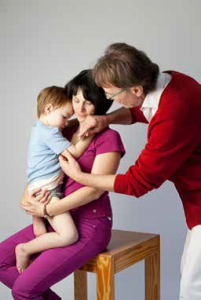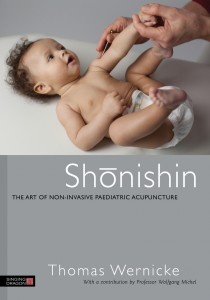Shōnishin is a non-invasive form of acupuncture developed specifically to respond to the needs of children. Instead of needles gentle stimulation all over the body is performed with a tool, which is rather like a nail, by different stroking techniques. In addition to the stroking techniques, different tapping techniques are used in certain areas and vibration techniques on acupuncture points.
In the past few years a steadily increasing interest in Shōnishin has become noticeable outside its home country of Japan, especially in Europe, Britain, and the United States.
So what makes Shōnishin so popular with therapists, parents and children? There are many reasons:
- Therapists see Shōnishin as a way of developing as a practitioner
- The treatment is simple and effective, and the successes speak for themselves
- Children love this treatment as it has a pleasant feel to them
- Parents are very accepting of the treatment as it is gentle and non-invasive.
Another reason for the spreading of Shōnishin is that this treatment method can be used field-specifically. Depending on the therapist’s professional background, as a doctor, alternative practitioner, Shiatsu-practitioner, physiotherapist or midwife, the patient collective, and thereby the indications, are different.
By way of example, approximately 70-80% of all midwifes in Germany have an acupuncture education – and thereby are qualified to practice Shōnishin. For them, Shōnishin offers great opportunities to support newborn babies suffering from feeding difficulties, abdominal pain, developmental problems or even excessive crying. In the event of a needle phobia, Shōnishin is an alternative for pregnant women while preparing for birth or as a supporting treatment for women who have recently given birth and suffer from involutional problems or blocked milk ducts.
The area of application of Shōnishin for orthopedics is completely different from that of midwives. Their focus is mainly on children with problems related to posture and the musculoskeletal system. On the other hand pediatricians apply Shōnishin with infants suffering from problems of the digestive system, the respiratory system or developmental disorders, whereas allergies and neurodermatitis are in the foreground with older children.
General practitioners are finding the technique useful for children or adolescents with concentration problems in school, ADHD or enuresis.
Shiatsu practitioners often apply Shōnishin in combination with baby-shiatsu or children-shiatsu, in order to support them in their development. Physiotherapists can show better successes in the treatment of hemiparetic children, as the usually increased tonicity can be decreased by additional treatment with Shōnishin and thereby the children become more treatable.
 For acupuncturists, especially for those who focus on treating children, a new field of action comes in appearance with Shōnishin, respectively an existing one can be widened. Furthermore, Shōnishin is an interesting supplement – or even an alternative for any therapist with acupuncture knowledge using manual methods.
For acupuncturists, especially for those who focus on treating children, a new field of action comes in appearance with Shōnishin, respectively an existing one can be widened. Furthermore, Shōnishin is an interesting supplement – or even an alternative for any therapist with acupuncture knowledge using manual methods.
Shōnishin is being used as an alternative to acupuncture in women’s shelters, mother-child facilities and nurseries. In this case women and children who are in difficult social or monetary situations, abandoned, without any obvious way out, are supported. These include traumatised women and children (for instance victims of rape), who are only able to permit touching due to the “interposed” Shōnishin instrument which means no dermal contact with the skin takes place.
Another field of application for Shōnishin will be in the treatment of the elderly. Particular parameters like skin conditions and mental conditions seem to show retrogression into childhood. First experiences with Shōnishin in residential care homes show promising treatment approaches. Even here it becomes obvious, that treatment with a Shōnishin instrument is advantageous: seniors often suffer from a shortage of physical contact. With Shōnishin the contact doesn’t take place directly, but indirectly with an instrument. For that reason seniors have no fear of contact and are willing to allow the treatment. Another advantage of treating elderly people with Shōnishin is that many of them have to take blood-thinning medicines. Due to the non-invasive and gentle treatment technique with Shōnishin, there is no contraindication.
Conclusion
Shōnishin is about to play an important role in the treatment of children. Shōnishin finds its application in doctor’s or acupuncturist’s surgeries, midwife work and increasingly in clinics. During the last years we can observe in the framework of congresses (TCM, acupuncture, pediatrics) an increasing demand for Shōnishin lectures and events. An increasing number of doctors and non-doctors (alternative practitioner, physiotherapists, midwives, Shiatsu-practitioners) are discovering this exceptionally gentle and effective type of treatment.
Thomas Wernicke is a licensed General Practitioner with qualifications in complementary medicine, Chinese and Japanese acupuncture. He has been the Training Manager for Daishi Hari Shōnishin in Europe since 2004. His new book: Shōnishin: The Art of Non-Invasive Paediatric Acupuncture is now available from Singing Dragon. This complete and user-friendly guide provides everything practitioners should know about Shōnishin and how this therapy can be used with different age ranges, especially young children.
